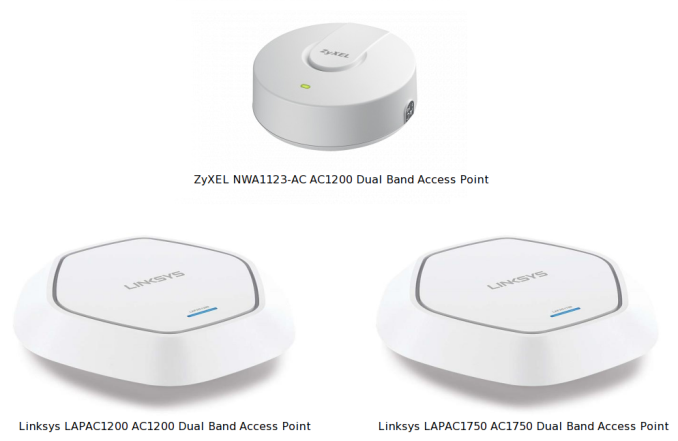Linksys and ZyXEL Launch Enterprise 802.11ac Access Points
by Ganesh T S on April 1, 2014 8:01 AM EST- Posted in
- Enterprise
- Networking
- Linksys
- 802.11ac
- ZyXEL

The enterprise Wi-Fi market is a hotly contested one with expensive offerings from companies such as Aruba Networks and Ruckus Wireless being the preferred choice of many IT administrators. Primary requirements for products in this market are the ability to support high client device densities and the provision of a robust and flexible management interface. We covered the launch of the Ubiquiti UniFi 3.0 and Xirrus XR620 earlier this year.
Traditional consumer Wi-Fi vendors have also started targeting offerings towards this expanding market segment recently. Coinciding with Interop 2014, we have Linksys launching two and ZyXEL officially launching one 802.11ac access point targeting business users. The Linksys LAPAC1200 is a 2x2 design, while the LAPAC1750 is a 3x3 one. The ZyXEL NWA1123-AC is a 2x2 design. All three devices are ceiling-mount units which are dual-band capable and support Power-over-Ethernet (PoE) to eliminate extra power connectors. As applicable to business users, we have support for multiple SSIDs, Layer-2 isolation, specific security features including 802.1X RADIUS authentication, MAC-based ACL etc.
The ZyXEL AP is based on the Qualcomm Atheros AR9342 CPU with a QCA9882 radio. It includes support for transmit beamforming (TxBF) and can have up to 128 wireless clients (64 per radio).
All three devices can operate as either stand-alone APs or repeaters. While the ZyXEL NWA1123-AC retails for a MSRP of $199, the Linksys LAPAC1200 and LAPAC1750 come in at $330 and $380 respectively. Small businesses / SOHO operations looking for a complete system would do well to combine the APs (and any surveillance cameras) with one of the sub-$250 fanless PoE+ switches from either vendor. ZyXEL has the GS1900-8HP GbE 8 Port PoE+ Web Managed Switch while Linksys has the LGS308P 8-Port Smart Gigabit PoE+ Switch in its portfolio. Both of them are fanless and support the latest 802.3at (PoE+) standard with a 70 W power budget.










8 Comments
View All Comments
Jorbas - Tuesday, April 1, 2014 - link
That access point sounds amazing i want one right now. PoE and ceiling mounting makes it even better.Gunbuster - Tuesday, April 1, 2014 - link
So these are not cloud managed and I don't see any mention of a controller. Calling them "Enterprise" might be a stretch. Maybe SOHO.AT should test out the offerings from Meraki and Aerohive.
Chapbass - Tuesday, April 1, 2014 - link
Just simply seeing "linksys" "zyxel" and "enterprise" in the same sentence without the word "isn't" in there, made me shake my head. Theres a separate line for Linksys' enterprise offerings, its called Cisco.Chapbass - Tuesday, April 1, 2014 - link
Scratch that, I forgot that Cisco sold it to Belkin. Fair enough, but still...Linksys hasn't exactly been hot in the enterprise space. Even their main page has the headline "Linksys Home Networking"toyotabedzrock - Tuesday, April 1, 2014 - link
What is the difference between these and a prosumer router?With all the recent security flaws in routers I almost want to build my out of a pc.
heffeque - Tuesday, April 1, 2014 - link
Read the article: "Primary requirements for products in this market are the ability to support high client device densities and the provision of a robust and flexible management interface."Mithan - Wednesday, April 2, 2014 - link
Enterprise will talk back to a controller, that usually has a nice GUI that allows you to configure each individual AP for whatever you want, put in a map overlay, get a lot of statistics and reports, etc, etc.As well, the AP themselves will support more users before bogging down. Obviously, you are still bandwidth limited but you are not processor limited in actually handling those devices. A consumer device might only handle 6-10 Wi-Fi connections before it runs like crap, regardless of the bandwidth going through the device. Enterprise can handle much more.
Plus you also get better quality parts (lol at that in my experience), outdoor versions, versions which you can add directional antennas too via RF cabling, etc, etc.
I wouldn't mind one of these for my house though, or even two of them and adding 1 on each floor.
name99 - Thursday, April 3, 2014 - link
Expanding a little on what's said above.A common problem in consumer base stations is that they limit the number of DHCP clients to 8 or so. You can sometimes work around this if you can a stable, controlled environment like your house (eg by giving some to all devices hardwired IP addresses), but it's a real problem in an office environment --- especially since there is no failure indication, all you see is that sometimes you can connect and sometimes you cannot.
Not ALL consumer base stations are so throttled. Apple's are not, and I would guess (but not promise) the same is true for the other high end base stations of comparable price.
Don't assume that these would be nice around your house just to be cool. You will, for example, need to buy a switch which can provide PoE --- no using your cheap home switch. You'll also have to have a dedicated computer as controller, or go through the hassle of setting up cloud control (which is one more point of failure you have to worry about and monitor).